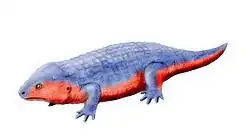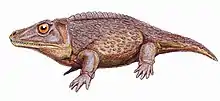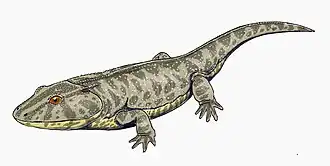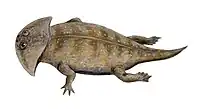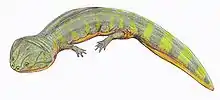| Nooxobeia Temporal range: Early Permian, | |
|---|---|
 | |
| Life restoration of Nooxobeia gracilis (right) based on specimen UCLA VP 3066. | |
| Scientific classification | |
| Domain: | Eukaryota |
| Kingdom: | Animalia |
| Phylum: | Chordata |
| Class: | Amphibia |
| Order: | †Temnospondyli |
| Family: | †Dissorophidae |
| Genus: | †Nooxobeia Gee, Scott & Reisz, 2018 |
| Type species | |
| †Nooxobeia gracilis Gee, Scott & Reisz, 2018 | |
Nooxobeia is an extinct genus of dissorophid temnospondyl from the Early Permian (Guadalupian) of Oklahoma. The generic name is derived from the Arapaho (a language spoken in the type locality of the holotype) word nooxobe, which means frog.[1]
Taxonomy
Olson (1972) referred a complete dissorophid specimen (UCLA VP 3066) from the Chickasha Formation of Oklahoma to Fayella chickashaensis based on cranial similarities to the holotype.[2] However, in 2018, Gee, Scott and Reisz declared Fayella a nomen dubium and an indeterminate temnospondyl, and made UCLA VP 3066 the holotype of the new species Nooxobeia gracilis.[1]
See also
References
- 1 2 Gee, Bryan M.; Scott, Diane; Reisz, Robert R. (2018). "Reappraisal of the Permian dissorophid Fayella chickashaensis". Canadian Journal of Earth Sciences. 55 (10): 1103–1114. doi:10.1139/cjes-2018-0053.
- ↑ Olson, Everett C. (1972). "Fayella chickashaensis, the Dissorophoidea and the Permian Terrestrial Radiations". Journal of Paleontology. 46 (1): 104–114. JSTOR 1302919.
This article is issued from Wikipedia. The text is licensed under Creative Commons - Attribution - Sharealike. Additional terms may apply for the media files.



